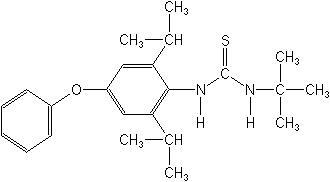Pesticides >> Insecticide >> Diflubenzuron
Diflubenzuron 20%SC
Insecticide
benzoylurea

NOMENCLATURE
Common name diflubenzuron (BSI, E-ISO, (m) F-ISO, ANSI, ESA)
IUPAC name 1-(4-chlorophenyl)-3-(2,6-difluorobenzoyl)urea
Chemical Abstracts name N-[[(4-chlorophenyl)amino]carbonyl]-2,6-difluorobenzamide
Other names DFB CAS RN [35367-38-5] Development codes DU 112307;
PH 60-40; PDD 60-40-I (all Duphar); TH 6040 (T. H. Agriculture &
Nutrition Co., Inc.) Official codes OMS 1804; ENT 29 054
APPLICATIONS
Biochemistry Chitin synthesis inhibitor; and so interferes with
the formation of the insect cuticle. This action is quite specific;
related biochemical processes, such as chitin synthesis in fungi,
and biosynthesis of hyaluronic acid and other mucopolysaccharides
in chickens, mice and rats are not affected. Mode of action Non-systemic
insect growth regulator with contact and stomach action. Acts at
time of insect moulting, or at hatching of eggs. Uses For control
of a wide range of leaf-eating insects in forestry, woody ornamentals
and fruit. Controls certain major pests in cotton, soya beans, citrus,
tea, vegetables and mushrooms. Also controls larvae of flies, mosquitoes,
grasshoppers and migratory locusts. Used as an ectoparasiticide
on sheep for control of lice, fleas and blowfly larvae. Due to its
selectivity and rapid degradation in soil and water, diflubenzuron
has no or only a slight effect on the natural enemies of various
harmful insect species. These properties make it suitable for inclusion
in integrated control programmes. Diflubenzuron is effective at
25-75 g a.i./ha against most leaf-feeding insects in forestry; in
concentrations of 0.01-0.015% a.i. against codling moth, leaf miners
and other leaf-eating insects in top fruit; in concentrations of
0.0075-0.0125% a.i. against citrus rust mite in citrus; and at a
dosage of 50-150 g a.i./ha against a number of pests in cotton (cotton
boll weevil, armyworms, leafworms), soya beans (soya bean looper
complex) and maize (armyworms). Also for control of larvae of mushroom
flies in mushroom casing (1 g a.i./m2); mosquito larvae (25-100
g a.i./ha); fly larvae in animal housings (0.5-1 g a.i./m2 surface);
and locusts and grasshoppers (60-67.5 g a.i./ha). Formulation types
GR; HN; OF; SC; UL; WG; WP. Compatibility Incompatible with strongly
alkaline products. Selected tradenames: 'Dimilin' (Uniroyal); 'Hilmilin'
(Hindustan)
OTHER TRADENAMES
'Adept' (Uniroyal); 'Micromite' (Uniroyal); 'Astonex' (Shell); 'Patron'
(Vapco)
ANALYSIS
Product analysis by hplc (CIPAC Proc., 1981, 3, 185; AOAC Methods,
1995, 983.07; A. van Rossum et al., Anal. Methods Pestic. Plant
Growth Regul., 1984, 13, 165). Residues determined by hplc or glc
after hydrolysis to 4-chloroaniline which is converted to a derivative
(B. Rabenort et al., ibid., 1978, 10, 57).
MAMMALIAN TOXICOLOGY
Reviews CAG; FAO/WHO 44, 46 (see part 2 of Bibliography). Oral Acute
oral LD50 for rats and mice >4640 mg/kg. Skin and eye Acute percutaneous
LD50 for rabbits >2000, rats >10 000 mg/kg. Not a skin irritant;
slight eye irritant (rabbits). Not a skin sensitiser (guinea-pigs).
Inhalation LC50 for rats >2.88 mg/l. NOEL (2 y) for rats 40 mg/kg
diet. No teratogenic, mutagenic, or oncogenic effect was observed.
ADI (JMPR) 0.02 mg/kg b.w. [1985]; 0.02 (JECFA evaluation) [1994].
Other Acute i.p. LD50 for mice >2150 mg/kg. Toxicity class WHO
(a.i.) III (Table 5); EPA (formulation) III
ECOTOXICOLOGY
Birds Dietary LC50 (8 d) for bobwhite quail and mallard ducks >4640
mg/kg diet. Fish LC50 (96 h) for zebra fish (Brachydanio rerio)
>0.2, rainbow trout >0.2 mg/l. Daphnia LC50 (48 h) 7.1 mg/l.
Algae LC50 for Selenastrum capricornutum >0.3 mg/l. Other aquatic
spp. LC50 for molluscs >200 mg/l. Bees Not hazardous to bees
and predatory insects; LD50 (oral and contact) >100 mg/bee. Worms
NOEC for Eisenia foetida 780 mg/kg substrate.
Diflubenzuron: ENVIRONMENTAL FATE
EHC 184 (WHO, 1996). Animals In rats, following oral administration,
elimination is partly as the unchanged parent compound in the faeces,
partly as hydroxylated metabolites (for c. 80%) and as 4-chlorophenylurea
plus 2,6-difluorobenzoic acid (for c. 20%). The intestinal absorption
is strongly related to the dosage administered - the higher the
dosage, the more (relatively) is excreted unchanged in the faeces.
See A. Verloop & C. D. Ferrell, ACS Symp. Series, 1977, No.
37, 237. Plants Non-systemic. Not metabolised on plants (idem, ibid.).
Soil/Environment Diflubenzuron is strongly absorbed by soil/humic
acid complex and is virtually immobile in soil. Rapidly degraded
in soil, with a half-life of <7 days. The principal degradation
products are 4-chlorophenylurea and 2,6-difluorobenzoic acid (idem,
ibid.).